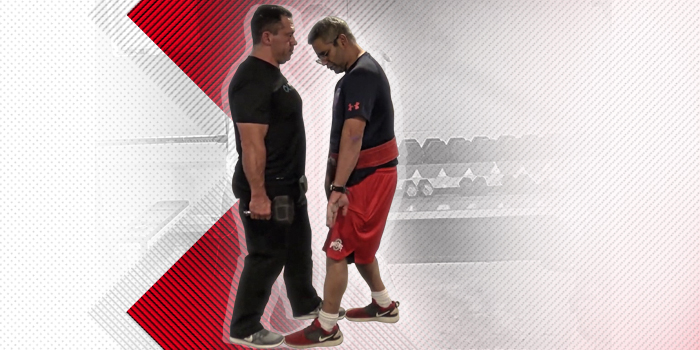
Coauthored by Dr. Eric Serrano, MD, and Scott H. Mendelson
Improve performance, development of the hamstrings, and reduce the risk of many injuries with the Staggered Leg Deadlift. A lack of hamstring strength and range of motion are two of the most common issues Dr. Eric Serrano, MD, treats to increase sprinting speed while reducing the frequency of pulled hamstrings.
This is a great exercise to use before the leg training session begins to activate the posterior chain and wake up dormant muscles. Feedback from numerous clients, including NFL athletes, tells us that squatting and running feel much better following this specialized movement.
The Set-Up
Pay close attention to foot position, as it is very common for trainees to internally or externally rotate the foot while performing any exercise. Take the time to ensure alignment and placement of the feet are correct to gain the most benefits from this unique exercise. The toe of the rear foot should be even with the heel of the front foot for proper spacing.
Bending at the Hip Instead of the Waist
Initiating the movement by bending at the hip and not the waist is the most challenging element of the exercise for trainees to learn. Focus on driving the hip backward as you begin the movement with the intention of reaching to touch a target behind you with your glutes. Keep a 20-degree bend in the front knee throughout the entire movement, which helps to shift tension to the hamstrings. Retract the shoulder blades to keep the chest out. Pick a spot on the floor as a visual marker to keep the dumbbells on the proper path. Driving the top of the dumbbell to be even with the toe of the front foot intensifies the hamstring contraction tremendously.
Stretching with Weight Load
Holding the contraction on the bottom of the rep for two to three seconds places tremendous tension on the lower insertion of the hamstring that’s closer to the knee joint. The bottom contraction serves as an intense stretch with loading, which may not be able to be achieved with traditional static stretching techniques. Even a small weight load helps to shift the body weight forward to gain more tension in the hamstrings. Keep focused on maintaining the 20-degree knee bend and keeping the shoulder blades retracted so that the torso remains in the proper position.
How Low Do You Go?
Dr. Serrano points out where the movement should end on the bottom when helping Scott Mendelson demonstrate the exercise from the side position. The range of motion can improve over time, but it is important not to over-stretch for the sake of doing so. The training partner should tell the trainee to stop moving downward before the lower back begins to round. Establishing this point during the first warm-up set will help the trainee gain a visual reference point by taking note of the position of the hands in reference to the front leg. Due to fatigue, many trainees will want to subconsciously reduce the range of motion during the second half of the set.
RECENT: Super Bowl Fat Loading Feast Options
Intensifications
Increasing the weight load can make the exercise more challenging and should be done incrementally so that proper form is not sacrificed. As a warm-up, the reps should be submaximal so they activate instead of causing a great deal of residual fatigue. Several of Dr. Serrano’s professional athlete patients have used the Staggered Leg Deadlifts and variations during the warm-up before NFL games with two to three sets of five reps using body weight only.
Build into the Weight Training Session
The Staggered Leg Deadlift was not developed for a high repetition count. Sets should not go above five reps for each leg and should always use a controlled speed of repetition. Loading can increase when this exercise is built into the training routine as a primary movement at the start of the training session. The muscles and nervous system should be fresh when incorporating a complex exercise that is new to ensure proper execution. Exercises such as squats, deadlifts, glute ham raises, reverse hypers, and other performance-oriented lower body movements can follow as needed.
A bodybuilder or physique athlete can also use this exercise to improve the visual development of the hamstrings.
Bringing out the Big Guns: Bands!
A small amount of tension with the partner pulling on the band results in an intense contraction of the hamstring of the front leg in particular. The glute on the side of the rear foot also becomes more engaged when the band is pulled carefully from the front. The back of the dumbbell becomes even with the toes of the front foot, which changes the loading pattern significantly. The concentric portion of the rep (returning to the top) becomes much more challenging as well due to the increase band tension from the front position.
Scott H. Mendelson, director of InfinityFitness.com, is a highly regarded performance nutrition and training specialist. In addition to designing customized programs for his celebrity, weekend warrior, and executive clients, Scott works daily with professional athletes from the NFL, NHL, MLB, NBA, and NCAA. Scott has built an excellent reputation providing effective supplements, cutting-edge information, and unmatched service to thousands of clients worldwide since 1999.
As special assistant to Dr. Eric Serrano, Scott helps with the design of training, nutrition, and supplementation trials to confirm the effectiveness of protocols and expand his expertise. Contact him at scott@infinityfitness.com.
Dr. Eric Serrano, MD, is the ace sought out by elite athletes and business professionals around the world for help with the most difficult of problems. Dr. Serrano spends a majority of his time promoting the success of his family practice patients in Pickerington, a suburb of Columbus, Ohio. Amongst the thousands of patients are elite athletes from around the globe who will travel to the ends of the earth to consult with Dr. Serrano.









